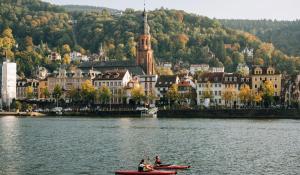
![cover98x127[2]_0](/sites/default/files/inline-images/cover98x127%5B2%5D_0.jpg)
A year ago, as then-presidential candidate Mitt Romney and President Barack Obama took jabs at each other in the media over the war in Afghanistan, the American auto industry bailout, and the national debt, one critical issue remained conspicuously absent—global warming.
Intensely frustrated over the fact that neither candidate had the courage to discuss this looming crisis, Bill McKibben, renowned writer, activist, and founder of 350.org, set out to talk to the American people about the dire state of the climate. He commissioned a bus to take himself and his staff on a cross-country tour called “Do the Math,” where he has been stepping onto stages in 21 cities—including at our San Francisco Green Festival—to lay out the numbers behind climate change in stark clarity, all of which add up to the end of life on Earth as we know it, he says, unless the world takes meaningful action, soon.
“In short, new research from financial analysts makes clear that the fossil fuel industry now has five times the carbon in its coal, oil, and gas reserves than the most conservative scientists and governments think would be safe to burn,” says McKibben, describing “the math” in a nutshell. “It’s a massive overkill—but it’s going to get dug up and sold unless we figure out how to stop them.”
A large part of the tour has been aimed at launching 350.org’s new divestment campaign, where McKibben has been asking students to pressure their colleges and universities to divest their endowments from fossil fuels. That’s right—to pull the top 200 oil, gas, and coal stocks completely out of their massive portfolios.
“We can’t stop climate change, but maybe we can keep it from getting utterly out of control,” says McKibben. “That will depend on reining in the fossil fuel industry. That’s why we’ve launched our massive divestment campaign (gofossilfree.org). We’ve got to turn fossil fuels into the new tobacco industry,” he says—one where people know its products are producing a cancer on the planet that must be curbed.
In planning the fossil-fuel divestment campaign, McKibben looked to the past, to the 1980s South Africa divestment movement. Divestment helped turn the tide in ending the brutal apartheid regime in South Africa, and McKibben and Green America hope that it will do the same for the fossil fuel industry. Signs are pointing to the fact that a massive shift in public and political will to heal the climate may be possible.
![MicKibben550w[1]](/sites/default/files/inline-images/MicKibben550w%5B1%5D.jpg)
Bill McKibben speaks during the "Do the Math" tour across the US.
A Change in the Weather
To grasp the seriousness of the climate crisis, says McKibben, “you just have to do a little math.” Namely, the math behind three figures: 2 degrees, 565 gigatons, and 2, 795 gigatons.
The scientists behind almost every government in the world say that any rise in the Earths’ temperature above 2°C (3.6°F) would result in catastrophic damage worldwide. We’ve already raised the temperature 0.8°C, says McKibben.
These scientists estimate that humans can pump only 565 gigatons of carbon dioxide into the atmosphere and have a reasonable hope of staying below 2°C.
“Computer models calculate that even if we stopped increasing CO2 levels now, the temperature would still rise another 0.8 degrees above the 0.8 we’ve already warmed, which means that we’re already three-fourths of the way to the two-degree target,” says McKibben.
The Carbon Tracker Initiative, a team of London financial analysts and environmentalists, estimates that the world’s proven oil, coal, and gas reserves equal 2,795 gigatons of CO2, or five times the amount the world can release and stay below the two-degree threshold of safety.
What do all of those numbers mean? We’re already seeing the effects of our march towards two degrees:
• July 2012 was the hottest month in recorded US history, reported the Associated Press, and 2012 is officially the warmest year on record in the US, with no record lows reached on any 2012 date. Nine of the ten warmest years on record worldwide have occurred since 2000, according to NASA.
• American farmers suffered catastrophic crop losses as 64 percent of the contiguous US experienced “moderate to severe drought” in 2012, according to the National Oceanic and Atmospheric Administration (NOAA).
• Despite 2012 being a La Niña year—a weather phenomenon that results in cooler than-normal ocean temperatures—January through October of this year was the warmest on record for the Arctic, states a report from the United Nations. In September, Arctic sea ice melted to its lowest point ever, having shed a total of 4.57 million square miles of ice, an area larger than the continental US.
• Perhaps nothing changed the conversation around climate change more than Typhoon Bopha and Hurricane Sandy. Typhon Bopha hit the Philippines shortly after Thanksgiving 2012, killing 800 people in the archipelago. This bizarre super-storm was the southernmost typhoon in recorded history. On the other side of the world, Hurricane Sandy decimated parts of Haiti, Jamaica, Cuba, and the US East Coast. Over 250 people died in the storm, and tens of thousands more were left homeless. Sandy was the strongest Atlantic storm to ever make landfall north of Cape Hatteras, NC.
Scientists have been linking increasingly violent storms to climate change for years, but it’s Hurricane Sandy that finally changed the conversation in the US.
A post-election survey by Penn Schoen Berland found that 60 percent of Americans who voted in the 2012 presidential election agree that “global warming made Hurricane Sandy worse,” and 73 percent agreed that “global warming is affecting extreme weather events in the US.”
“That debate is mostly over,” says McKibben. “Polling data show a huge upsurge in Americans believing in climate change. Our problem is not converting the last skeptics, its convincing the people who understand the problem to join in the fight.”
Time to Divest
As climate deniers become fewer in number and farther out on the fringe, the fossil fuel divestment movement is stepping in to increase the public will to catalyze meaningful action.
In under two months, the student bodies of over 210 campuses are solidly on board, from big state schools like the University of Michigan to small liberal arts colleges like Amherst. In comparison, 155 college campuses, together with churches, pension funds, and local governments, helped end apartheid through divestment.
Why divestment? As McKibben notes, “we can’t stop global warming one pipeline, coal plant, or fracking well at a time—the numbers just don’t add up.”
It’s time to go to the root of the problem, he says, and pull the financial rug out from under the fossil fuel companies themselves: “We’ll make sure they hear us in terms they might understand, like their share price.”
“Green America is throwing our full support behind the call for fossil fuel divestment, just as we played a leading role in the South African divestment movement in the 1980s,” says Alisa Gravitz, Green America president/CEO. “To me, what’s most powerful about divesting from fossil fuels is that it focuses on moving money from the worst planet-destroying companies to the green economy—reinvesting in companies that are involved in clean energy, clean water, sustainable agriculture, and restoring the health of the planet and communities.”
![rollercoaster550w[1]](/sites/default/files/inline-images/rollercoaster550w%5B1%5D.jpg)
The roller coaster on Casino Pier in Seaside Heights, NJ, sits in the ocean in the aftermath of Hurrican Sandy.
–Tracy Fernandez Rysavy







